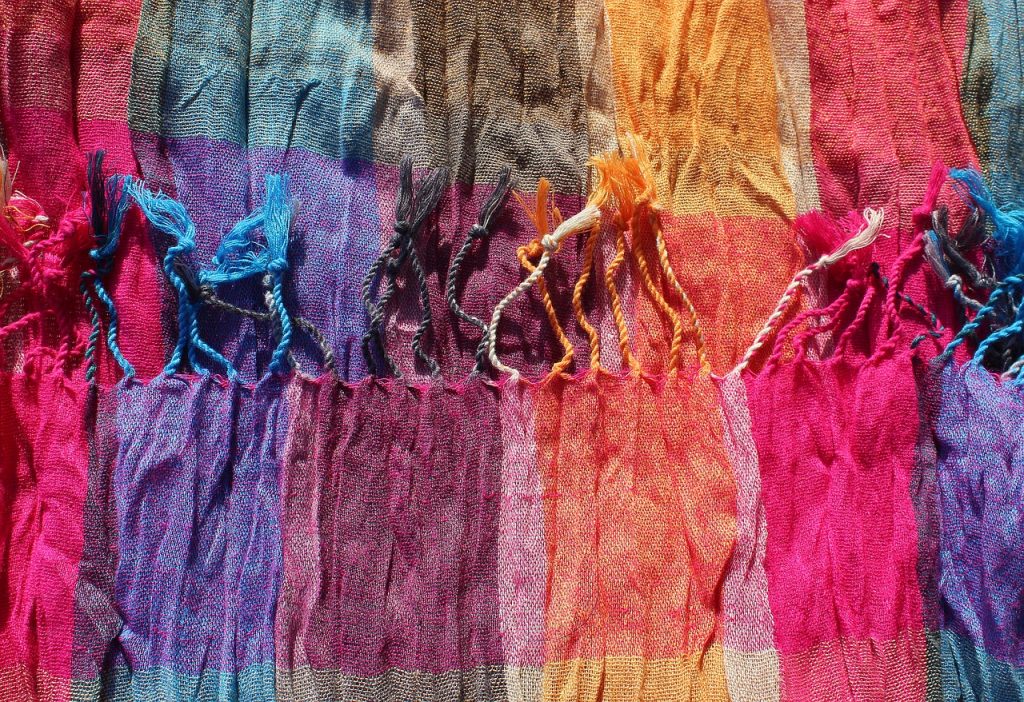A very popular commodity from Jammu and Kashmir that features on the shopping list of almost every tourist who visits this beautiful state is the Kashmiri shawl. The Kashmir shawl, also known as Cashmere, is known for its distinctive Kashmiri weave, and is made from shahtoosh or pashmina wool. Kashmiri shawls are lightweight and warm, and have beautiful designs. The use of buta (also called boteh) motif, an almond or pine cone-shaped motif with a sharp-curved upper end, is characteristic to these shawls. Kashmiri shawls are famous not just in India but all over the world. It is because of Kashmiri shawls that the buta design gained popularity in Europe. The trade of Kashmir shawls has greatly boosted the cashmere industry.
History of the Kashmir Shawls
Kashmir shawls have a long history that dates back to the 15th century. Tradition says that Zayn-ul-ʿĀbidīn, a 15th-century ruler of Kashmir, established the cashmere industry. He brought weavers from Turkistan into Kashmir. The earliest shawls were plain with borders that had designs of flowers, flower vases, and pine cones. Texts written between 3rd century BC and 11th century AD mention woolen shawls, but the first references to Kashmiri designs appear in the 16th century writings.
In 1526, Babur started the practice of giving khilat (robes of honour) to members of his court, as a token of appreciation of their work. The khilat was a set of clothes that included a shawl, among other apparel, made from pashmina. During Akbar’s rule (1586 onwards), a pair of Kashmir shawls was given as khilat. During Shah Jahan’s rule, shahtoosh shawls were given to members of Mughal royalty, while pashmina shawls were given as khilat. From the 16th to the early 20th century, rulers of the Safavid, Zand, and Qajar dynasties continued the tradition of giving Kashmir shawls as khilat.
Ranjit Singh from Punjab, who started ruling Kashmir in 1819, further popularized Kashmiri shawls. In the 1840s, his court was decorated using Kashmir shawls. He used these shawls to pay allowances, to honour members of the court, and even to send gifts.
In the latter half of the 18th century, the English and French brought Kashmir shawls from India to Europe. They were given as gifts for women. During the 19th century, the shawls were categorized as pashm shala (made from domesticated goats’ hair) and asli tush (made from wild goats’ hair).
Queen Victoria of the United Kingdom and Empress Josephine of France gave patronage to Kashmir shawls. Empress Josephine even owned a collection of a few hundred Cashmere shawls. Soon, media took notice of this and the Kashmir shawl featured in French fashion magazines. This led to a further rise in the popularity of Kashmir shawls among women.
Since the Europeans had fondly embraced Kashmir shawls, their designs were modified to match their liking. To scale up their manufacturing, mechanized shawl industries were established by France and Great Britain. One such major industry was the one set up in Paisley, Scotland, where cashmere shawls were woven by machine.
Due to machine weaving, the time required to weave these shawls significantly reduced, and so did their cost. The cashmere industry in Kashmir suffered. In the effort to get back in competition, the hand weavers of Kashmir started imitating the Paisley designs. To match the speed of machine-weaving, they could not maintain the earlier quality. This resulted in the collapse of the Kashmir shawl industry. In the mid-20th century, the government started taking measures to revive this once-successful industry.
Famous Kashmir Shawls and Embroideries
Pure Pashmina Shawl
It represents the art and creativity of the weavers of Kashmir. It was one of the highly valued shawls of the olden times and even the Europeans were impressed by the Pashmina designs.
Kani Shawls
These come from the weavers in a village called Kanihama. They are woven using kanis, wooden sticks used as spools with several coloured threads. Mughals, Sikhs and even the British were mesmerized by the beauty of these shawls. Akbar is believed to have been a collector of Kani shawls.
Tilla Shawls
Tilla embroidery is known for its royal look. These shawls are made using pure cashmere wool and initially, gold and silver threads were used for the embroidery.
Some of the famous types of hand embroideries used in Kashmir shawls include sozni which has designs based on Paisley and floral patterns, paper mache embroidery, which is a bolder version of sozni, kalamkari, in which sozni embroidery is seen over hand-painted patterns, and aari embroidery (also called kashida kari) which can be seen on Raffal shawls.
According to references in literature and archeological texts, shawls existed in India since the time of the Indus Valley civilization. Once worn as a protective clothing against the cold, shawls evolved into a style icon. For long, they have been a symbol of royalty. Today, they are popular as gifts and worn on special occasions. Originally, shawls were meant to be worn by men, but over the years, women adopted them and turned them into a fashion statement.
Today, Kashmir shawls tell stories of the long history and rich culture of India. They are popular across the globe for their exquisite designs and beautiful embroidery. Even today, when they are mass-produced using machines and their designs have undergone changes, the elegance of shawls hand-woven by the weavers of Kashmir remains unmatched.



